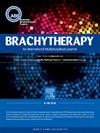颊粘膜癌近距离放疗新技术——创新思维!
IF 1.7
4区 医学
Q4 ONCOLOGY
引用次数: 0
摘要
目的:近距离放疗(BT)可单独或联合外束放疗(EBRT)用于早期头颈癌的治疗。在为口腔黏膜癌规划种植体时可能会遇到技术挑战,这需要定制解决方案。我们提出了一个定制的3D打印模板近距离治疗的设计和应用在一个这样的情况。材料与方法:68岁女性,左侧颊黏膜外生性疣状病变2.5 × 2 cm,拒绝手术切除。她计划接受最终的近距离放射治疗。病变位于后上方,靠近磨牙后三角区和龈颊上沟。这对将种植体放置在规则的平行方式提出了技术挑战,特别是提供足够的后缘和上缘。因此,一个垂直模板为基础的种植计划。三维(3D)打印技术允许使用增材制造技术从数字模型创建3D物理对象。使用根据患者解剖结构定制的3D打印技术创建了一个新的模板,以指导导管的放置符合Paris系统的植入规则。结果:患者对治疗耐受良好,治疗3周后出现三级黏膜炎贴片代替病灶。在3个月时,她有完全的反应,没有口干和导管入口点的皮肤色素沉着。她目前正在随访1年,没有临床或放射学证据表明患病。结论:根治性近距离放射治疗早期口腔黏膜病变疗效显著。可以使用3D打印创建定制模板,在技术上困难的头颈癌病例中执行ISBT。本文章由计算机程序翻译,如有差异,请以英文原文为准。
A novel technique of brachytherapy for carcinoma of the buccal mucosa—Thinking out of the box!
PURPOSE
Brachytherapy(BT) can be used alone or in conjunction with external beam radiotherapy (EBRT) in the management of early head and neck cancers. Technical challenges may be encountered while planning implants for buccal mucosal cancers, which require customized solutions. We present the design and application of a customized 3D printed template for brachytherapy in one such case.
MATERIALS AND METHODS
A 68 year old lady with an exophytic verrucous lesion of 2.5 × 2 cm in her left buccal mucosa refused to undergo surgical excision. She was planned for definitive Brachytherapy. The lesion being placed posteriorly and superiorly had a close proximity to the retromolar trigone and the upper gingivobuccal sulcus. This posed a technical challenge to place the implant in the regular parallel fashion, especially to provide adequate posterior and superior margins. Hence a perpendicular template based implant was planned.
Three-dimensional (3D) Printing technology allows the creation of 3D physical objects from digital models using the additive manufacturing technology. A new template was created using 3D print technology customized to the patient's anatomy, to guide the placement of catheters in congruence with the Paris system of implant rules.
RESULTS
Patient tolerated the treatment well and had grade three mucositis patch replacing the lesion at 3 weeks post treatment. At 3 months, she had a complete response with no xerostomia and minimal hyperpigmentation of overlying skin at catheter entry points. She is currently on follow-up at 1 year with no clinical or radiological evidence of disease.
CONCLUSIONS
Radical Brachytherapy offers excellent outcomes in early buccal mucosal lesions. Customized templates may be created using 3D printing to perform ISBT in Head and Neck Cancers in technically difficult cases.
求助全文
通过发布文献求助,成功后即可免费获取论文全文。
去求助
来源期刊

Brachytherapy
医学-核医学
CiteScore
3.40
自引率
21.10%
发文量
119
审稿时长
9.1 weeks
期刊介绍:
Brachytherapy is an international and multidisciplinary journal that publishes original peer-reviewed articles and selected reviews on the techniques and clinical applications of interstitial and intracavitary radiation in the management of cancers. Laboratory and experimental research relevant to clinical practice is also included. Related disciplines include medical physics, medical oncology, and radiation oncology and radiology. Brachytherapy publishes technical advances, original articles, reviews, and point/counterpoint on controversial issues. Original articles that address any aspect of brachytherapy are invited. Letters to the Editor-in-Chief are encouraged.
 求助内容:
求助内容: 应助结果提醒方式:
应助结果提醒方式:


